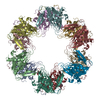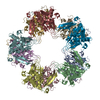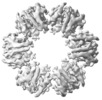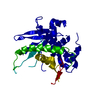[English] 日本語
 Yorodumi
Yorodumi- EMDB-23047: Cryo-EM structure of Mal de Rio Cuarto virus P9-1 viroplasm prote... -
+ Open data
Open data
- Basic information
Basic information
| Entry |  | |||||||||||||||
|---|---|---|---|---|---|---|---|---|---|---|---|---|---|---|---|---|
| Title | Cryo-EM structure of Mal de Rio Cuarto virus P9-1 viroplasm protein (dodecamer) | |||||||||||||||
 Map data Map data | Cryo-EM structure of Mal de Rio Cuarto virus P9-1 viroplasm protein (dodecamer) | |||||||||||||||
 Sample Sample |
| |||||||||||||||
 Keywords Keywords | Fijivirus / MRCV / Wheat / Maize / Reoviridae / viroplasm / VIRAL PROTEIN | |||||||||||||||
| Function / homology | Reovirus P9-like / Reovirus P9-like family / p9-1 Function and homology information Function and homology information | |||||||||||||||
| Biological species |  Mal de Rio Cuarto virus Mal de Rio Cuarto virus | |||||||||||||||
| Method | single particle reconstruction / cryo EM / Resolution: 6.8 Å | |||||||||||||||
 Authors Authors | Llauger G / Melero R | |||||||||||||||
| Funding support |  Argentina, 4 items Argentina, 4 items
| |||||||||||||||
 Citation Citation |  Journal: mBio / Year: 2023 Journal: mBio / Year: 2023Title: A Fijivirus Major Viroplasm Protein Shows RNA-Stimulated ATPase Activity by Adopting Pentameric and Hexameric Assemblies of Dimers. Authors: Gabriela Llauger / Roberto Melero / Demián Monti / Gabriela Sycz / Cristián Huck-Iriart / María L Cerutti / Sebastián Klinke / Evelyn Mikkelsen / Ariel Tijman / Rocío Arranz / Victoria ...Authors: Gabriela Llauger / Roberto Melero / Demián Monti / Gabriela Sycz / Cristián Huck-Iriart / María L Cerutti / Sebastián Klinke / Evelyn Mikkelsen / Ariel Tijman / Rocío Arranz / Victoria Alfonso / Sofía M Arellano / Fernando A Goldbaum / Yann G J Sterckx / José-María Carazo / Sergio B Kaufman / Pablo D Dans / Mariana Del Vas / Lisandro H Otero /    Abstract: Fijiviruses replicate and package their genomes within viroplasms in a process involving RNA-RNA and RNA-protein interactions. Here, we demonstrate that the 24 C-terminal residues (C-arm) of the P9-1 ...Fijiviruses replicate and package their genomes within viroplasms in a process involving RNA-RNA and RNA-protein interactions. Here, we demonstrate that the 24 C-terminal residues (C-arm) of the P9-1 major viroplasm protein of the mal de Río Cuarto virus (MRCV) are required for its multimerization and the formation of viroplasm-like structures. Using an integrative structural approach, the C-arm was found to be dispensable for P9-1 dimer assembly but essential for the formation of pentamers and hexamers of dimers (decamers and dodecamers), which favored RNA binding. Although both P9-1 and P9-1ΔC-arm catalyzed ATP with similar activities, an RNA-stimulated ATPase activity was only detected in the full-length protein, indicating a C-arm-mediated interaction between the ATP catalytic site and the allosteric RNA binding sites in the (do)decameric assemblies. A stronger preference to bind phosphate moieties in the decamer was predicted, suggesting that the allosteric modulation of ATPase activity by RNA is favored in this structural conformation. Our work reveals the structural versatility of a fijivirus major viroplasm protein and provides clues to its mechanism of action. The mal de Río Cuarto virus (MRCV) causes an important maize disease in Argentina. MRCV replicates in several species of plants and planthopper vectors. The viral factories, also called viroplasms, have been studied in detail in animal reovirids. This work reveals that a major viroplasm protein of MRCV forms previously unidentified structural arrangements and provides evidence that it may simultaneously adopt two distinct quaternary assemblies. Furthermore, our work uncovers an allosteric communication between the ATP and RNA binding sites that is favored in the multimeric arrangements. Our results contribute to the understanding of plant reovirids viroplasm structure and function and pave the way for the design of antiviral strategies for disease control. | |||||||||||||||
| History |
|
- Structure visualization
Structure visualization
| Supplemental images |
|---|
- Downloads & links
Downloads & links
-EMDB archive
| Map data |  emd_23047.map.gz emd_23047.map.gz | 49 MB |  EMDB map data format EMDB map data format | |
|---|---|---|---|---|
| Header (meta data) |  emd-23047-v30.xml emd-23047-v30.xml emd-23047.xml emd-23047.xml | 14.2 KB 14.2 KB | Display Display |  EMDB header EMDB header |
| Images |  emd_23047.png emd_23047.png | 81.9 KB | ||
| Filedesc metadata |  emd-23047.cif.gz emd-23047.cif.gz | 6 KB | ||
| Archive directory |  http://ftp.pdbj.org/pub/emdb/structures/EMD-23047 http://ftp.pdbj.org/pub/emdb/structures/EMD-23047 ftp://ftp.pdbj.org/pub/emdb/structures/EMD-23047 ftp://ftp.pdbj.org/pub/emdb/structures/EMD-23047 | HTTPS FTP |
-Related structure data
| Related structure data |  7kvdMC  7kvcC M: atomic model generated by this map C: citing same article ( |
|---|---|
| Similar structure data | Similarity search - Function & homology  F&H Search F&H Search |
- Links
Links
| EMDB pages |  EMDB (EBI/PDBe) / EMDB (EBI/PDBe) /  EMDataResource EMDataResource |
|---|
- Map
Map
| File |  Download / File: emd_23047.map.gz / Format: CCP4 / Size: 52.7 MB / Type: IMAGE STORED AS FLOATING POINT NUMBER (4 BYTES) Download / File: emd_23047.map.gz / Format: CCP4 / Size: 52.7 MB / Type: IMAGE STORED AS FLOATING POINT NUMBER (4 BYTES) | ||||||||||||||||||||
|---|---|---|---|---|---|---|---|---|---|---|---|---|---|---|---|---|---|---|---|---|---|
| Annotation | Cryo-EM structure of Mal de Rio Cuarto virus P9-1 viroplasm protein (dodecamer) | ||||||||||||||||||||
| Voxel size | X=Y=Z: 0.85 Å | ||||||||||||||||||||
| Density |
| ||||||||||||||||||||
| Symmetry | Space group: 1 | ||||||||||||||||||||
| Details | EMDB XML:
|
-Supplemental data
- Sample components
Sample components
-Entire : Dodecameric complex of Mal de Rio Cuarto virus P9-1 viroplasm protein
| Entire | Name: Dodecameric complex of Mal de Rio Cuarto virus P9-1 viroplasm protein |
|---|---|
| Components |
|
-Supramolecule #1: Dodecameric complex of Mal de Rio Cuarto virus P9-1 viroplasm protein
| Supramolecule | Name: Dodecameric complex of Mal de Rio Cuarto virus P9-1 viroplasm protein type: complex / ID: 1 / Parent: 0 / Macromolecule list: all |
|---|---|
| Source (natural) | Organism:  Mal de Rio Cuarto virus Mal de Rio Cuarto virus |
-Macromolecule #1: p9-1
| Macromolecule | Name: p9-1 / type: protein_or_peptide / ID: 1 / Number of copies: 12 / Enantiomer: LEVO |
|---|---|
| Source (natural) | Organism:  Mal de Rio Cuarto virus Mal de Rio Cuarto virus |
| Molecular weight | Theoretical: 44.933328 KDa |
| Recombinant expression | Organism:  |
| Sequence | String: MRGSHHHHHH GMASMTGGQQ MGRDLYDDDD KDRWGSELEI CSWYHGGRGN SIADLERRTF GSYKIEEITI KNDQQQKTTN QQQISNNEQ RISTKKIPIL DDGIFDLINY LLNGTHFDKT HYCGFDYSHL PTLERDFNTA SNYVSENYSI IVEEIDLNKY E RSESISLK ...String: MRGSHHHHHH GMASMTGGQQ MGRDLYDDDD KDRWGSELEI CSWYHGGRGN SIADLERRTF GSYKIEEITI KNDQQQKTTN QQQISNNEQ RISTKKIPIL DDGIFDLINY LLNGTHFDKT HYCGFDYSHL PTLERDFNTA SNYVSENYSI IVEEIDLNKY E RSESISLK SPDFTVVLEY FKKHVEGQTE QEENKTESTS SELPAKIVRE LPLLPIMCRE SEDSISEDIL EGEGAVIQVL KM FMKGFLV HLGENPNSYD RQLTIEKYRP LLISIIGYEF TVGTRATHTK INHIYYQLAT FDNYPFDLLR FQLQSLIDTP NVI KERIEK DGLFKVITTT NARGQYQSVL LRGINGSESY LNLKRYRKFK VRVVGNVDNV IKNDFSSLKL DV UniProtKB: p9-1 |
-Experimental details
-Structure determination
| Method | cryo EM |
|---|---|
 Processing Processing | single particle reconstruction |
| Aggregation state | particle |
- Sample preparation
Sample preparation
| Buffer | pH: 7.6 / Component:
| ||||||
|---|---|---|---|---|---|---|---|
| Grid | Model: Quantifoil R2/2 / Material: COPPER/RHODIUM / Mesh: 300 / Support film - Material: CARBON / Support film - topology: HOLEY | ||||||
| Vitrification | Cryogen name: ETHANE / Chamber humidity: 100 % / Instrument: LEICA EM CPC | ||||||
| Details | No previous negative glow discharge was applied on the grids in order to avoid protein aggregation |
- Electron microscopy
Electron microscopy
| Microscope | FEI TALOS ARCTICA |
|---|---|
| Image recording | Film or detector model: FEI FALCON III (4k x 4k) / Average electron dose: 30.0 e/Å2 |
| Electron beam | Acceleration voltage: 200 kV / Electron source:  FIELD EMISSION GUN FIELD EMISSION GUN |
| Electron optics | Calibrated defocus min: 0.8 µm / Illumination mode: OTHER / Imaging mode: OTHER / Nominal defocus max: 3.8000000000000003 µm / Nominal magnification: 120000 |
| Experimental equipment |  Model: Talos Arctica / Image courtesy: FEI Company |
+ Image processing
Image processing
-Atomic model buiding 1
| Initial model | PDB ID: Chain - Source name: PDB / Chain - Initial model type: experimental model |
|---|---|
| Refinement | Space: REAL / Protocol: FLEXIBLE FIT / Overall B value: 175 / Target criteria: Correlation coefficient |
| Output model |  PDB-7kvd: |
 Movie
Movie Controller
Controller





